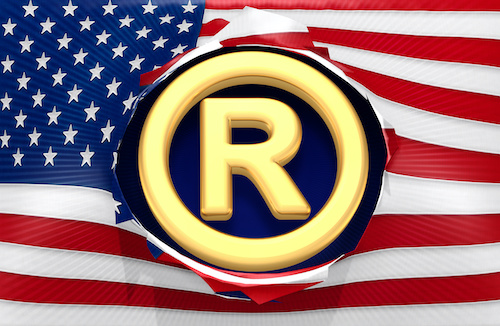“Just because goods and services fall within the class covered by your application does not mean you should include them in the application. Including extraneous goods or services with which the mark has not been used will subject your registration to re-examination.”
 Most people associate the Consolidated Appropriations Act of 2020 with its COVID relief and stimulus measures, rather than trademarks. While these measures are of course the primary focus of the Act, its changes to the process of registering, maintaining, and enforcing trademarks are likewise important for companies that rely on their branding to achieve their business goals. The Trademark Modernization Act, which is one of many acts included in the Consolidated Appropriations Act, makes several significant changes to the Lanham Act (aka the Trademark Act) which many trademark holders may find beneficial.
Most people associate the Consolidated Appropriations Act of 2020 with its COVID relief and stimulus measures, rather than trademarks. While these measures are of course the primary focus of the Act, its changes to the process of registering, maintaining, and enforcing trademarks are likewise important for companies that rely on their branding to achieve their business goals. The Trademark Modernization Act, which is one of many acts included in the Consolidated Appropriations Act, makes several significant changes to the Lanham Act (aka the Trademark Act) which many trademark holders may find beneficial.
The Trademark Modernization Act (TMA) includes three key provisions, which:
(1) formalize a simpler and cheaper procedure for challenging trademark applications;
(2) establish a new process for cancelling registrations based upon lack of use; and
(3) created a national presumption, which lowers the standard of proof for trademark owners seeking to enjoin trademark infringement by their competitors.
The first two provisions become effective on December 27, 2021, while the third provision became effective on December 27, 2020, the date on which the Consolidated Appropriations Act was signed into law.
1) Challenging Pending Trademark Applications
Prior to the enactment of the TMA, third parties believing that they may be damaged by the federal registration of a mark were limited to filing an opposition during a 30-day opposition period occurring just before registration of the mark in question. The TMA alters not only the timing for, but more importantly the mechanism by which third parties can oppose a pending trademark application. Rather than engaging in what can be a lengthy and expensive form of litigation before the Trademark Trial and Appeal Board, the TMA allows a party to oppose the registration of the mark by submitting a letter of protest that identifies a valid ground for refusing registration of the applied for mark along with supporting evidence. While there are a number of valid grounds for refusing registration of a mark, the most common are that the mark in question (a) is likely to cause consumer confusion with another trademark (i.e. the opposer’s); or (b) is merely descriptive, primarily geographically descriptive or deceptively mis-descriptive of the goods or services identified in the application.
If the U.S. Patent and Trademark Office (USPTO) determines that the letter of protest states a valid and supported grounds for rejection, the opposer’s evidence will be provided to the Trademark Examiner in charge of examining the application in question so that the Examiner may use the evidence to support the opposer’s suggested refusal. This procedure provides would-be opposers three significant advantages. First, the letter of protest may be submitted any time prior to the application’s approval, as opposed to its submission being limited to the 30-day opposition period. Second, unlike an opposition, which can be a timely, complex and expensive proceeding, the new letter of protest procedure may prove to be a simpler, cheaper and faster option than the existing opposition proceeding. Third, the letter of protest provides would-be opposers with two bites at the apple in that even if the letter of protest is not accepted, an opposition may still be filed during the opposition period.
Key Takeaway: Trademark owners should consider setting up a trademark watch service to be alerted when potentially conflicting marks are filed. Doing so allows trademark owners to preserve their ability to file a letter of protest and to potentially reduce the cost of challenging problematic trademarks. A trademark attorney can help you determine whether such a strategy makes sense and, if so, what would be involved.
2) Cancelling Trademark Registrations Based Upon Non-Use
The TMA provides for two new cancellation procedures in hopes of clearing the Trademark Registry of “deadwood” registrations for marks that have never been used in association with some (or all) of the goods and services identified in the registration. These new procedures will offer trademark holders and applicants an expedited method for removing from their path, registrations that otherwise may serve as a basis for refusal of their trademark applications. Under these new procedures, any party may petition the USPTO to either (1) expunge a registration for a trademark that has never been used in commerce, or (2) re-examine any registration on the grounds that as of the date the declaration of the mark’s use was filed, the mark was not in use with some of the goods or services identified in the registration.
While not expressly stated in the TMA, the expungement procedure is intended for foreign registrations. Unlike applications that were originally filed in the USPTO, applications that rely on an application or registration previously filed abroad need not provide proof of the mark’s use in U.S. commerce prior to receiving a U.S. registration. Instead, such marks can be registered upon the filing of a verified statement that the applicant has a bona fide intent to use the mark in the U.S. Consequently, the Trademark Registry has become congested with registrations fraudulently obtained by foreign applicants who have never used their marks in the U.S. The expungement proceeding is intended to clear the Trademark Registry of these fraudulent registrations.
The re-examination procedure provides a process for challenging registrations based upon a false, but not necessarily fraudulent, declaration of the mark’s use in association with the goods and services identified in the registration. When preparing a trademark application, applicants often include many (or all) of the goods and services that fall within the “class” of goods or services initially selected by the applicant. They do so, because their filing fee covers the entire class and the inclusion of more goods and services provides the resulting registration with a broader scope of protection. This practice violates the spirit of the law, which requires actual use of the mark in association with each good or service identified in the registration. To rectify the proliferation of overzealous registrations resulting from this practice, the re-examination procedure allows for the cancellation from the registration, each good or service with which the mark was not being used as of the filing date of the mark’s declaration of use.
Any party wishing to challenge a registration may submit a petition for either expungement or re-examination. Petitions for expungement must be filed between the third and tenth anniversary of the registration date of the mark in question while petitions for re-examination may be filed at any time prior to the fifth anniversary of the mark’s registration date. In either case, the petitioning party must identify the registration, identify the goods or services for which the mark has not been used and verify that the submitting party conducted a “reasonable investigation” of registrant’s non-use.
If the USPTO finds that the petition, whether for expungement or re-examination, sets forth a prima facie case of non-use, the USPTO will commence the requested proceedings by notifying the registrant and providing it an opportunity to respond with evidence of the mark’s use. However, if the challenge fails, no future challenges will be allowed against the same registration based on non-use of the goods or services identified in the unsuccessful petition. These new petitions provide a more streamlined and cost-effective alternative to the formal cancellation proceeding, which currently exists.
Key Takeaway: When dealing with your own application, remember that just because goods and services fall within the class covered by your application does not mean you should include them in the application. Including extraneous goods or services with which the mark has not been used will subject your registration to re-examination. Even after registration, it remains important to continue using your mark in association with all of the goods and services identified in the registration.
When dealing with third party registrations, it may be worth investigating whether the registered mark has been used in association with the goods and services identified therein. If, after a reasonable investigation, it appears that the mark has not been used, a petition for reexamination or expungement may be warranted. If successful, these petitions may help clear potentially troubling marks from your path to registration or give you leverage in any infringement dispute in which you may be involved.
3) Lowering the Standard of Proof for Enjoining Infringement
When seeking to enjoin a competitor from using a confusingly similar mark (and thus, committing infringement) a trademark owner needs to prove, among other things, that it is (1) likely to succeed on the merits of its infringement claim and (2) likely to suffer irreparable harm in the absence of the injunction. Unfortunately, courts from different parts of the country have recently developed a disagreement about how a trademark owner should prove a likelihood of irreparable harm because of the continued infringement. Some courts held that upon proving a likelihood of success on the infringement claim, the trademark owner is entitled to a presumption that irreparable harm will result. Other courts held that no presumption applies and that the trademark owner must present evidence of irreparable harm, which can be difficult task.
In order to address this difference of opinion, the TMA established a national presumption of irreparable harm that arises upon the showing a likelihood of success on the merits of the infringement claim (when seeking a temporary injunction) or actual success on the merits (when seeking a permanent injunction). While the presumption may be rebutted by the defendant, it shifts the burden of presenting evidence regarding irreparable harm (or a lack thereof) to the defendant, making it much easier for trademark owners to protect their trademarks.
Key Takeaway: With the new lowered standard of proof, preliminary injunctions have become a more readily available weapon that trademark owners can use to defend their trademark rights. Trademark owners should consider being more aggressive in their use of temporary injunctions as a means of achieving a quick resolution to their trademark disputes. That is because in most cases, alleged infringers who are preliminarily enjoined from using the mark during the pendency of the lawsuit are incentivized (and often do) settle the dispute shortly after the injunction is issued.
Remember, the presumption is rebuttable so trademark owners who routinely seek injunctive relief should be prepared, if necessary, to prove a likelihood of irreparable harm resulting from the continued infringement. Evidence of irreparable harm could include evidence of: the owner’s loss of control of business reputation, irate customers, frayed vendor relationships, tangible threats to the owner’s market share, the infringer’s lack of quality control or, in some instances, the inability of the infringer to pay damages.
A Win Overall
If branding plays an important role in your company’s success, be sure to familiarize yourself with the TMA’s new provisions or to consult an attorney who is familiar with them. The TMA affects not only the steps available to trademark applicants seeking a trademark registration but also the steps that trademark registrants must take to maintain their registrations and those that they may take to enforce their trademark rights. While not all of its provisions are clear-cut improvements for trademark owners, as a whole, the TMA certainly favors U.S. based trademark owners and provides them with several significant advantages.
Image rights acquired via AdobeStock.

![[IPWatchdog Logo]](https://ipwatchdog.com/wp-content/themes/IPWatchdog%20-%202023/assets/images/temp/logo-small@2x.png)

![[Advertisement]](https://ipwatchdog.com/wp-content/uploads/2024/05/Quartz-IP-May-9-2024-sidebar-700x500-1.jpg)
![[Advertisement]](https://ipwatchdog.com/wp-content/uploads/2024/04/Patent-Litigation-Masters-2024-sidebar-last-chance-700x500-1.jpg)
![[Advertisement]](https://ipwatchdog.com/wp-content/uploads/2024/05/Patent-Portfolio-Management-2024-sidebar-super-early-bird-with-button-700x500-1.jpg)
![[Advertisement]](https://ipwatchdog.com/wp-content/uploads/2024/05/Artificial-Intelligence-2024-Getting-AI-Patents-Allowed-sidebar-700x500-1.jpeg)

![[Advertisement]](https://ipwatchdog.com/wp-content/uploads/2021/12/WEBINAR-336-x-280-px.png)
![[Advertisement]](https://ipwatchdog.com/wp-content/uploads/2021/12/2021-Patent-Practice-on-Demand-recorded-Feb-2021-336-x-280.jpg)
![[Advertisement]](https://ipwatchdog.com/wp-content/uploads/2021/12/Ad-4-The-Invent-Patent-System™.png)







Join the Discussion
No comments yet.